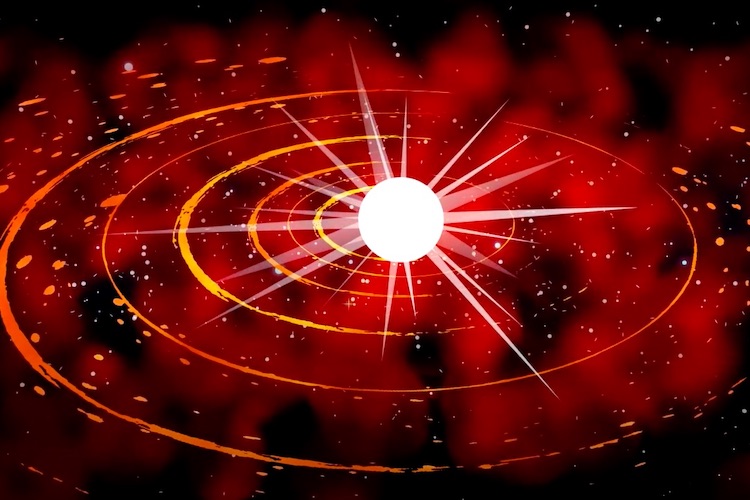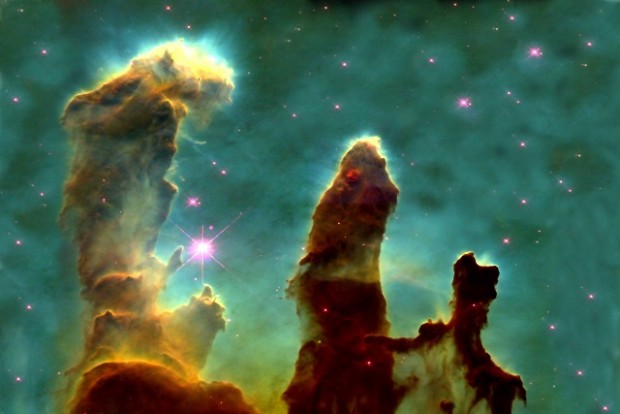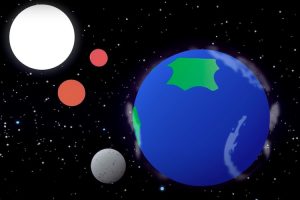The climate and habitability of planets with etern...
The new research investigates the climate states of rocky planets of Earth and Super-Earth-sizes with stable d...

The Kuiper Belt (KB) is a region in the Solar system beyond Neptune, with an outer edge that is indistinct and undefined. We actually don’t know what happens on the outer edge of the Kuiper Belt or where it is, but we do know that it’s very far away: some of the Kuiper Belt objects already discovered have eccentric orbits that swing out to 2000 times the Earth-Sun distance.
The Kuiper Belt wasn’t predicted in any meaningful way. Nobody wrote a paper saying, “Look here for objects this bright, this big, and this many”. But there were speculations. The most famous one, of course, is by Gerard Kuiper, a Dutch/American astronomer. He wrote a paper in 1951 saying that it’s strange that the Solar System just ends at Pluto… maybe it just continues outwards. That part sounds good to modern ears. But the other thing he said was, “If there once were many small bodies in the outer regions of the Solar System, then the gravity of Pluto, (which he believed to be a massive body, as massive as the Earth, or more) would long-since have destabilized the orbits of these things, and so the region should be empty”. Kuiper was wrong about Pluto (it’s not massive, containing only 0.2% of the mass of Earth), and it doesn’t have much effect on nearby objects. The great irony about the Kuiper Belt is that Kuiper didn’t predict the Kuiper Belt. He predicted that it wouldn’t be there! It’s an example of Stigler’s Law: “No scientific discovery is named after the person who discovered it” (Stigler’s Law is said to have been discovered by Robert Merton, proving its accuracy).
Even before that, there were other speculations, including one made in 1943, in the middle of WWII, by an Irish guy called Kenneth Edgeworth. He wrote one or two sentences in a short paper speculating, “Maybe there are some bodies in the outer Solar system that are too faint for us to see (he called them “clusters”), and maybe they’re related to comets”. But it’s not a scientific prediction, it’s not quantitative, it’s not based on anything, and you cannot do anything with this kind of speculation. It reminds me of writing from the 16th century by Nostradamus, occasionally credited with predicting WWII and the assassination of President Kennedy, amongst other amazing things. If you write something sufficiently vague, then there will be room in the future for others to look back and imagine you knew what you were talking about when perhaps you didn’t. Hindsight is 20/20.

When we started the search for the Kuiper Belt in 1986, computers were so puny that nobody could integrate the Solar System to see how the dynamics worked. They had to work with analytical approximations, and that’s very hard. At that time, there was a lot of interest in where the short-period comets might come from because it was clear that the accepted source (the spherical Oort Cloud) was not right. Julio Fernández, an Uruguayan astronomer, wrote a paper in 1980 speculating that there might be a region beyond Neptune that supplied the short-period comets. And that paper was the closest to being a prediction. Unlike the work by Kuiper and Edgeworth, in retrospect, it still looks good, but it didn’t motivate a big search by anybody, including us. It was, although it sounds bad to say, just another theory paper.
The ‘scientific method’ is often described by the idea that theories make predictions that are tested by observations. But science usually doesn’t work like that. In astronomy, almost nothing is done through predictions, and almost everything of importance is discovered by chance. Theories are then created or adapted to explain the new things that have been observed. It’s quite rare to have any kind of actionable prediction that is then tested or confirmed via observation. We are just not good enough to do that. Still, without any model, we did know in 1985 that it seemed very weird that the Solar system in the outer parts would be extremely empty. Beyond Saturn, there were Uranus, Neptune, and Pluto — three things — whereas the inner Solar system was full of junk: asteroids, comets, and other planets. And that was very strange: why should the Solar system be empty out there and very full in the inner regions? So that was a motivation for doing our survey. Is it empty because all other objects have been scattered away, or is it empty because distant objects are too faint to have been seen? We didn’t think about the Kuiper Belt; we didn’t think about “beyond Neptune” we would have been really happy with one object beyond Saturn at that time because there was nothing else to talk about. So, we actually created a survey which we called the ‘slow moving object survey’ targeted to look for anything beyond Saturn.
It turns out to be very tricky to estimate the distance to an object unless you adopt a very specific geometry to point the telescope exactly opposite to the direction of the Sun. When you do that, the speed of the object as it moves across the sky is inversely related to its distance because of parallax. It’s like two airplanes: a high-flying one going 500 miles an hour takes a long time to creep across the sky, while a low-flying airplane with the same speed but just above your head zooms across very fast. So from the apparent speed, we could measure the distance. We used that very simple tactic of looking opposite to the Sun, and then we used parallax to estimate the distance. That’s why we called it the ‘slow moving object’ survey; we were looking for slow-moving objects because they should be the ones that are very far away.
And it turns out we didn’t find anything interesting for years. We did find lots of objects in the inner Solar system, like asteroids, but we didn’t see anything beyond the targeted Saturn. We spent about five years doing this survey and finding just nothing of value until 1992, when we finally found an object. It was not just beyond the orbit of Saturn but far beyond the known region of the solar system. What came to be called 1992 QB1 was the most distant thing ever seen in the solar system, by a long shot.
It was absolutely thrilling. And the deal is that before you find the first one, you don’t know if your search is hopeless or pointless, you don’t know if you’re doing the right thing, and you don’t even have confidence that there is anything to find. But as soon as you have the first one in the bag, then all these doubts are obliterated. Somehow it affects the way you work, the way you think, so you are really breaking through a psychological barrier as well as a detection barrier. What’s almost impossible before it’s done becomes routine after it’s done. I worked together with Jane Luu, who was a postdoc at that time. After finding the 1992 QB1, we began to pick them up more easily. We found 40-50 objects over the next few years. Other people soon joined the game, and the total number now known (mid-2016) is approaching 2,000. That’s a lot!

Fig. 1: The Kuiper Belt object is the bright moving dot indicated by the arrow. Photo by NASA’s New Horizons spacecraft, April 2016
We immediately made many amazing discoveries about the Kuiper Belt. For example, we discovered that there are different kinds of Kuiper Belt objects. We gave different names to them: classical, resonant, scattered, and detached ones. They are dynamically different from each other, mostly for reasons to do with gravitational control by planet Neptune, which is pretty massive (16 times the Earth’s mass) and not that far away from at least some of these Kuiper Belt objects. Neptune imposes a dynamical structure on the Kuiper Belt through its gravitational influence. We showed that Pluto is just a big Kuiper Belt object. We determined the size distribution and the mass in the Kuiper Belt. We realized that we had the tip of the iceberg: from the objects we could see, we inferred 100 000 Kuiper Belt objects bigger than a hundred kilometers and probably a billion objects bigger than one kilometer. To think that they were all completely unknown before is staggering.
Even though there are many, many Kuiper Belt objects, we found that their combined mass is quite small, only 10% of the mass of the Earth. That raised a bit of a puzzle: how could these bodies form, given that they have very little mass? With so little material spread over the huge volume of the Kuiper Belt, it just takes too long for these bodies to grow. So, models of the small mass of the Kuiper Belt became an instant hot topic. They were settled on the idea that the Kuiper Belt, when it formed, was much more massive, maybe from 20 to 40 times the Earth’s mass, but almost all of this mass was somehow lost.
The key to understanding how the mass was lost comes from another observation that we made, namely that many Kuiper Belt objects are trapped in what’s called ‘mean-motion resonance’ with Neptune. It means that their orbit period divided by the orbit period of Neptune is the ratio of small integers. For example, in the 3 to 2 mean-motion resonance Neptune completes three orbits around the Sun in the time it takes the Kuiper Belt object to complete 2. It means that the gravitational force of Neptune is periodically applied to bodies in that orbit, so the force can add and add, like pushing a child on a swing, so the force can accumulate with time.
This was figured out by a person in Arizona, Renu Malhotra, in the early 1990s, soon after the discovery of the Kuiper Belt. The first resonant objects lead to this very nice model. But the question is how you get these objects into the resonance. Because if you just sprinkle the Kuiper Belt objects at random, very few of them will go into a resonance compared to the number that we see. The explanation for that was also Renu’s, building on earlier work by Fernandez and Wing Ip, namely that the planets must be migrating. The radii of the orbits of the planets haven’t always been the same: Neptune, for example, started closer to the Sun and moved outwards. And as it moved outwards, its resonances were pushed out and picked-up objects from the Kuiper Belt, like pushing a plow through the snow, with the snow building up on the shovel. As a resonance went out through the Kuiper Belt, objects stuck onto the resonance, explaining why there are so many bodies in mean-motion resonance. That’s really the only explanation ever suggested that makes sense to account for the large number of objects being in resonance with Neptune. Kuiper Belt shows that the planets did not form in the orbits they now occupy. Migration matters.
The Kuiper Belt has affected our understanding of the origin and dynamics of the Solar System in a huge way. Before, the Solar System was like a clock: a set of planets moving around the Sun, leisurely, stable, predictable, and kind of boring. After the Kuiper Belt was found, especially because of the resonant objects that require a radial migration of the planets, crazy possibilities began to emerge. If the planets drifted to where they are now, they might have passed through resonances with each other. If that happened, they might have shaken up the Solar System, allowing instabilities and many weird, chaotic things to happen. In some models, the loss of perhaps 99.9% of the original Kuiper Belt objects may have occurred in a savage shaking of the solar system forced by a mean-motion interaction between Jupiter and Saturn, all caused by planet migration.
Comets are usually not very big (roughly a kilometer), and they lose mass (into the tail). So we can calculate how long a comet can lose mass at the rate that we measure. And the answer is that it’s not very long, 10,000 years maybe. Comet nuclei cannot possibly last from the beginning of the Solar System, which is 4.5 billion years ago, and must have been recently emplaced in the Solar System. In other words, they are just arriving in the inner Solar System, somewhere near the Earth, and as soon as they do, they begin to vaporize away. The question is, where do they come from?
There are two answers to that. The first part was realized in 1950 by a Dutch astronomer, Jan Oort. He pointed out that long-period comets (orbit periods bigger than 200 years) have very elliptical orbits of very large size that are distributed randomly. There are equal numbers coming in this way and that way, from the Northern Hemisphere and the Southern Hemisphere; they come from a spherical or isotropic source. This spherical source, now called Oort Cloud, is a bit like a giant swarm of bees surrounding the Solar System. It’s a huge thing, from 50,000 to 70,000 times the distance between the Earth and the Sun, and it is the source of the long-period comets. We don’t observe objects in the Oort Cloud because they are too faint for our telescopes. Everything we know about the Oort Cloud, including its existence, has been inferred from comets that have already been knocked out of the Oort Cloud by the gravity of passing stars.

Fig. 2: Comet ISON Passes Through Virgo. The comet began its trip from the Oort cloud region. Photo by NASA’s Marshall Space Flight Center, November 2013
On the other hand, ‘short-period’ comets (periods less than 200 years) have relatively small and circular orbits. They are not randomly distributed. Instead, they are aligned with the orbital plane of the Solar System. The question in this case also always was where do they come from? Oort’s answer was that they must be from the Oort Сloud but that Jupiter has been able to capture and deflect their orbits into a kind of disk. That was the accepted idea from 1950 into the 1980s, a long-long time. But it turns out to be very difficult for Jupiter to capture enough long-period comets from the Oort Cloud and convert their orbits into the short-period type.
The Kuiper Belt, we know, turns out to supply the short-period comets. And since the Belt is much closer (50 AU instead of 50,000 AU for the Oort Cloud), we can actually observe it directly instead of just looking at objects deflected out into the near-Earth environment. This is another reason why the KB has made such a big splash in planetary science.
The ‘Debris Disks’ are analogs of the Kuiper Belt but located around other stars. The observation there is that many Solar-type stars have dusty disks in which the dust particles in the disks can’t survive very long. The argument is similar to comets. We can calculate how long the dust should survive, and it’s not very long. Therefore, the fact that the stars are still dusty means that the dust must be resupplied from some source. The Kuiper Belt model is the best that we have for the likely dust source. One difference is that most debris disks are more massive than the Kuiper Belt. This fits with the idea that the Kuiper Belt, in the beginning, was much more massive than it is now. When we see massive debris rings around other stars, that’s a clue to what the young Solar System might have looked like.
We have a much better view of the solar system than we did before the Kuiper Belt was discovered, but we still can’t see its distant parts very clearly, if at all. We can’t observe the Oort Cloud because it’s too far away and too faint. Even the outer parts of the Kuiper Belt can’t be directly detected. We’d like to know how and where the Kuiper Belt blends into the Oort Cloud, assuming that it does. We’d like to measure the orbital structure of the belt in much more detail so that we can have stronger clues about the origin and evolution of the solar system. For example, resonance trapping works differently if the planets migrate slowly and smoothly versus quickly and in a jumpy fashion. Measurements of Kuiper Belt objects’ orbits can potentially tell us how Neptune migrated and perhaps even when and for how long. And, while models have adapted quickly to retroactively fit new observations of the outer solar system, there are some features that remain mysterious. The outer edge of the classical Kuiper Belt, for example, is not a natural consequence of models so far proposed. Future observations may help to solve this mystery but, more importantly, to reveal new ones that will improve our overall understanding of the solar system. Eventually, we’d like to explore the Kuiper Belt with spacecraft. Sadly, existing rocket technology is not up to the task, and for many decades to come, progress will come exclusively from observations with ground and space-based telescopes.
Edited by Ekaterina Vylomova

The new research investigates the climate states of rocky planets of Earth and Super-Earth-sizes with stable d...

Physicist Nergis Mavalvala on the general theory of relativity, Hulse-Taylor system, and the way gravitational...

Astrostatistician Alan Heavens on the expanding Universe, cosmological constant, and why our cosmological mode...